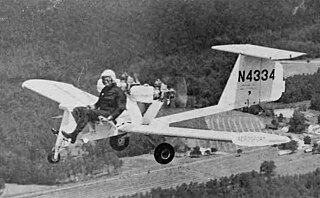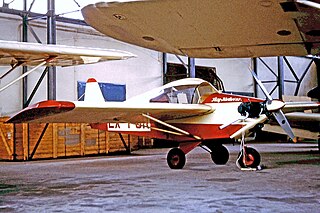
The Aerosport Rail is an American minimalist ultralight aircraft, designed by Harris Woods and built by Aerosport Inc. The aircraft was first flown on 14 November 1970.

The Sonerai is a small, VW-powered homebuilt aircraft, designed by John Monnett. The Sonerai began to compete as a single-seat, mid-wing, tailwheel Formula-V racer class formed in 1972. The Sonerai soon evolved into a two-seat model called the Sonerai II.

The Bryan Autoplanes were a series of three experimental roadable aircraft.

The Salvay-Stark Skyhopper I is a low-wing single-place homebuilt aircraft designed in 1944.
The Westfall Sport is a single seat biplane modeled after the Waco F2.
The Strojnik S-2 is an American high-wing, single-seat motor glider that was designed and built by Aleš Strojnik.
The Jupiter J-1 is a single-seat, low wing, homebuilt aircraft with fiberglass covered wood airframe construction.
The Scott Ol' Ironsides is an early homebuilt aircraft using wood construction with stressed fiberglass panel construction.
The Hanson Woodwind is an all-wooden homebuilt aircraft with a fiberglass wing.
The Staib LB-4 a.k.a. Staib Airyplane is a homebuilt aircraft design of Wilbur Staib.
The Aristocraft II was a six-place homebuilt aircraft designed by Terrence O'Neill.
The O'Neill Model J Magnum, also called the Magnum Jake and the Magnum Pickup, is a homebuilt aircraft design for bush flying operations similar to the de Havilland Beaver.
The Turner T-40 is a wooden, single-seat, homebuilt aircraft that was designed by Eugene L. "Gene" Turner, first flying on 3 April 1961.
The Dempsey TD-3 Beta Lightning is the second original homebuilt aeroplane design by Thomas Dempsey.

The Stits SA-5 Flut-R-Bug is a homebuilt aircraft designed by Ray Stits.

The Polen Special, is a homebuilt racing aircraft built to become the fastest four cylinder aircraft in the world.
The Shirlen Big Cootie is an American homebuilt biplane that was designed by Roy Shirlen.
The Rayner Pusher is a homebuilt version of the Curtiss Pusher.

The Historical Ryan STA was an American homebuilt aircraft that was designed and produced by the Historical Aircraft Corporation of Nucla, Colorado. The aircraft was an 85% scale replica of the original Ryan STA and when it was available was supplied as a kit for amateur construction.
The Parrish Dart is an American canard-configuration homebuilt aircraft that was designed by Jimmy R. Parrish and produced by Parrish Aircraft Xperimental, Inc. of Plantation, Florida. It first flew in the Autumn of 1995. When it was available the aircraft was supplied in the form of plans for amateur construction.







